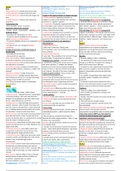Samenvatting
Summary Complete Cheat Sheet - Operations and Process Management (OPM)
- Instelling
- Universiteit Van Amsterdam (UvA)
An extensive double sided cheat sheet which is allowed to use during the exam. It consists all the necessary information per week from the lectures, workgroups and the textbook (Slack, 2016, 8th edition). Due to this cheat sheet I received a 8,8 for the exam. The important terms are red and the for...
[Meer zien]










